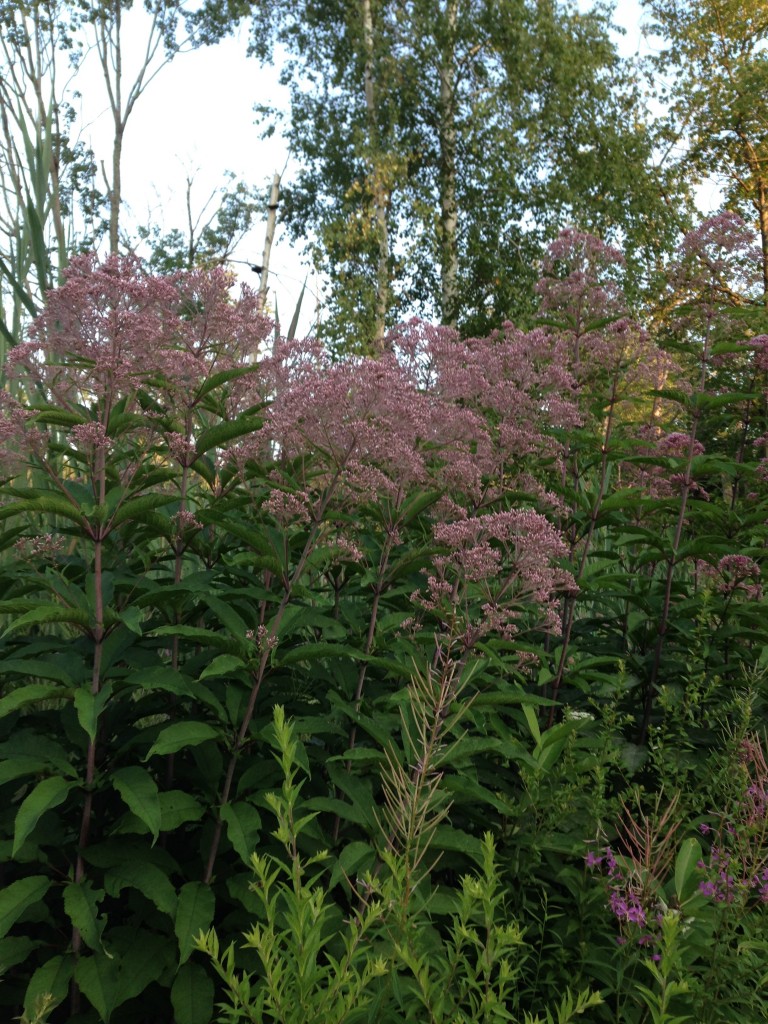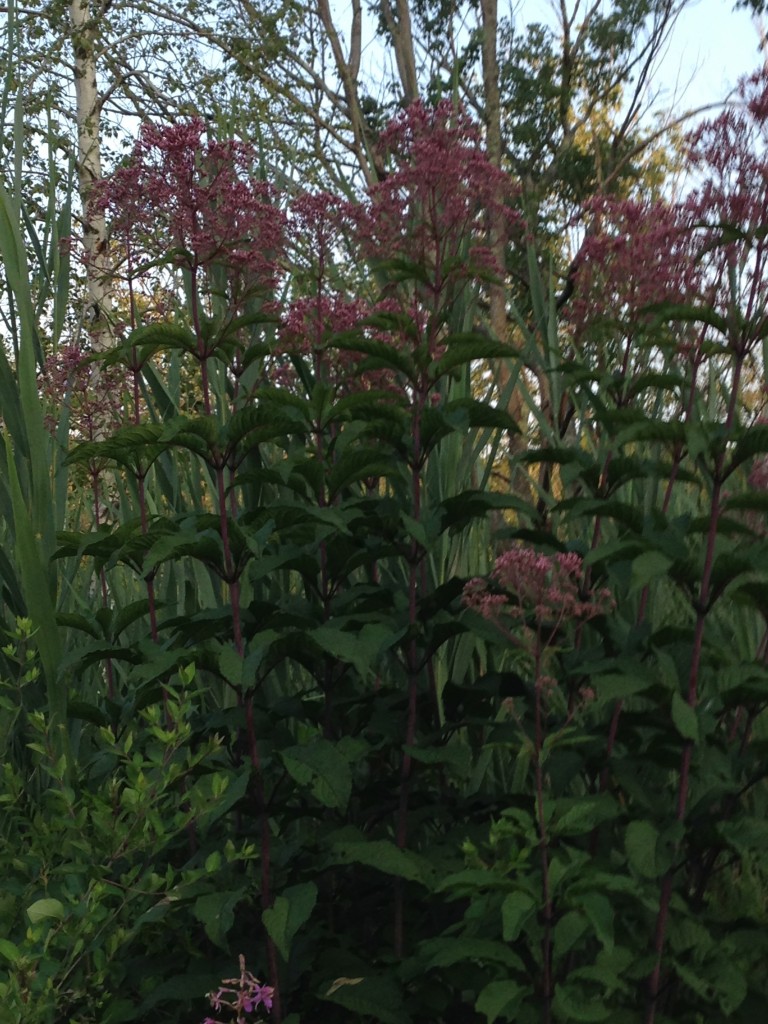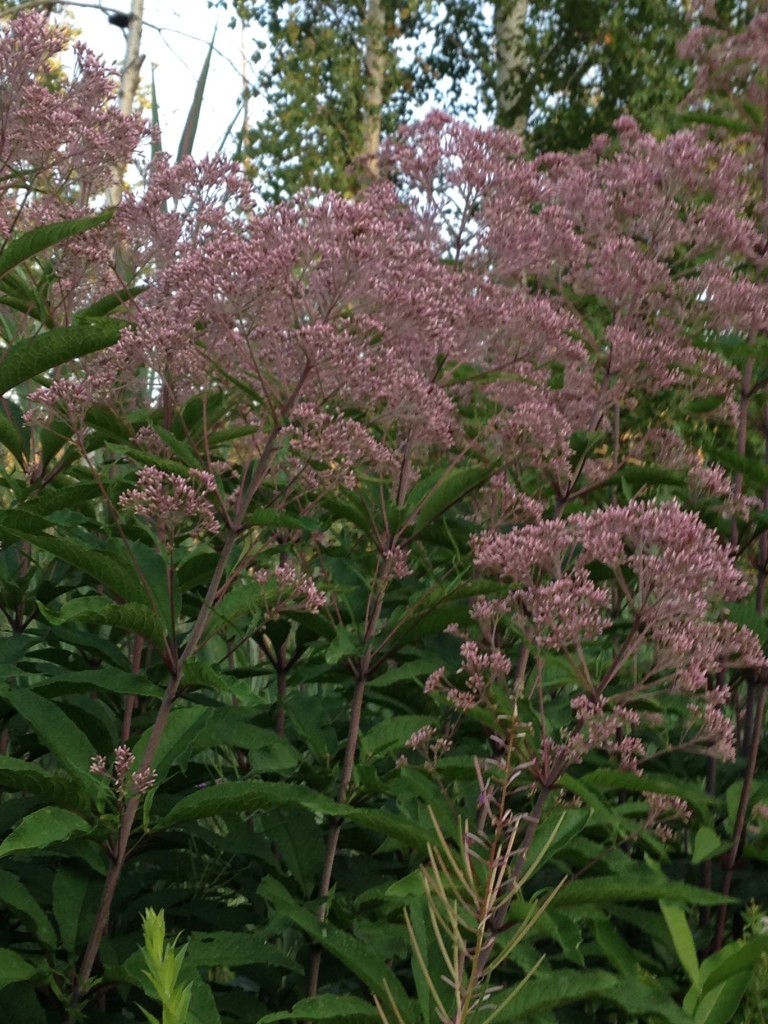Walking past a marsh I see regularly in these last days of July and early days of August, it is easy to feel overwhelmed by the scale of some of the plants. Above my head, smoky plumes of purple hover like a haze, a thick crown of mauve blossoms. These are the later summer foliage of summer wet meadows, and habitat for common pollinators. Both are in the larger plant family that sunflowers are in, the Asteraceae.
The taller, Ironweed, is one of the seventeen North American species of the genus Vernonia, named after the English Botanist William Vernon. World-wide, there are about 1000 species in this genus, many of which are eaten for food or used medicinally. Although I am not certain of the species, I believe these extraordinary plants you see are probably Vernonia gigantea (Tall Ironweed, or Giant Ironweed). If not, they are a close relative, and I do know that they are native plants, descendants of the 2,000 wetland plants that were planted in this wetland restoration in 2001.
Above: Iron weed is slightly taller, its leaves slightly darker and its flowers less spread out than the Joe-Pye weed in the same area
World-wide, ironweeds are culturally important. Members of the genus in Africa are important parts of diets, eaten as leaf vegetables and used in soups. In Cameroon, they are widely consumed and used in a dish called “ndole’” Some of the plants in the genus have anti microbial properties, and others have been used to treat diabetes, fevers, and joint pain. Vernonia galamensis, a relative grown in Ethiopia, is used as an oilseed, producing an oil used for industrial purposes. The ironweed we have might have medicinal leaves, although I’m certain you shouldn’t just go chewing on it, and it doesn’t have oil-producing seeds. Nonetheless it is lovely.
A similarly striking plant, slightly smaller and slightly lighter in color, is Joe-Pye weed (Eutrochium purpureum). This rugged wetland plant is also native and has several other common names including: Kidney-root, Scented Joe-pie weed, Trumpet weed and Gravel root. It is a perennial plant that forms clumps. This plant is also in a genus of closely related plants, and there is a possibility that the ones we see are one of those other relatives. For those of you who don’t know how exciting plant taxonomy can be, when I first worked with Joe-Pye weed, I learned it as a member of the genus Eupatorium. Sometime when I was not paying attention, those busy taxonomists split the genus and put Joe-Pye weeds and close relatives in a new genus.
Above: Joe-Pye weed was used by Native Americans as a medicinal plant. It looks similar to , but a little lighter than the Ironweed int he same area
I first encountered Joe-Pye weed in my research in the Midwest. I have fond memories of late summer and early fall slogs through wetlands, looking for the flowers of fall as the leaves of summer plants browned and curled. The dark leaves and earth tones of both Ironweed and Joe-Pye weed lend some of the richness and texture that characterize upper Midwestern wetlands. Browns and russets abound in a landscape that to a first view looks flat and unremarkable. As in almost everything I study, the remarkable becomes obvious with closer inspection. The bright color of spring is gone this time of year, but a depth emerges, and endless variations on green, brown, red and purple turn the upper, drier portion of the marsh into a zone of interest and mystery.
Here in New England, these plants were called “Joe-Pye” weed after an indigenous word “Jopi”. Like ironweed, Joe-Pye weed has medicinal properties; folklore holds that it was used by Native Americans and colonists against kidney stones, and fevers, including typhus outbreaks.
I am hoping we will not need to raid the marsh upland for emergency medicines, but that you, like me, will take a moment to look at the lovely later summer purples high above your heads.



